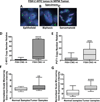Frequent coamplification and cooperation between C-MYC and PVT1 oncogenes promote malignant pleural mesothelioma
- PMID: 24926545
- PMCID: PMC4287384
- DOI: 10.1097/JTO.0000000000000202
Frequent coamplification and cooperation between C-MYC and PVT1 oncogenes promote malignant pleural mesothelioma
Abstract
Introduction: Malignant pleural mesothelioma (MPM) is a deadly disease with poor prognosis and few treatment options. We characterized and elucidated the roles of C-MYC and PVT1 involved in the pathogenesis of MPM.
Methods: We used small interfering RNA (siRNA)-mediated knockdown in MPM cell lines to determine the effect of C-MYC and PVT1 abrogation on MPM cells undergoing apoptosis, proliferation, and cisplatin sensitivity. We also characterized the expression of microRNAs spanning the PVT1 region in MPM cell lines. Copy number analysis was measured by quantitative polymerase chain reaction and fluorescence in situ hybridization.
Results: Copy number analysis revealed copy number gains (CNGs) in chromosomal region 8q24 in six of 12 MPM cell lines. MicroRNA analysis showed high miR-1204 expression in MSTO-211H cell lines with four copies or more of PVT1. Knockdown by siRNA showed increased PARP-C levels in MSTO-211H transfected with siPVT1 but not in cells transfected with siC-MYC. C-MYC and PVT1 knockdown reduced cell proliferation and increased sensitivity to cisplatin. Analysis of the expression of apoptosis-related genes in the MSTO-211H cell line suggested that C-MYC maintains a balance between proapoptotic and antiapoptotic gene expression, whereas PVT1 and, to a lesser extent, miR-1204 up-regulate proapoptotic genes and down-regulate antiapoptotic genes. Fluorescence in situ hybridization analysis of MPM tumor specimens showed a high frequency of both CNGs (11 of 75) and trisomy (three copies; 11 of 75) for the C-MYC locus.
Conclusion: Our results suggest that C-MYC and PVT1 CNG promotes a malignant phenotype of MPM, with C-MYC CNG stimulating cell proliferation and PVT1 both stimulating proliferation and inhibiting apoptosis.
Conflict of interest statement
Figures



Similar articles
-
Impact of metallothionein-knockdown on cisplatin resistance in malignant pleural mesothelioma.Sci Rep. 2020 Oct 29;10(1):18677. doi: 10.1038/s41598-020-75807-x. Sci Rep. 2020. PMID: 33122816 Free PMC article.
-
ZIC1 is silenced and has tumor suppressor function in malignant pleural mesothelioma.J Thorac Oncol. 2013 Oct;8(10):1317-28. doi: 10.1097/JTO.0b013e3182a0840a. J Thorac Oncol. 2013. PMID: 24457242
-
Signal Transducer and Activator of Transcription 1 (STAT1) Knock-down Induces Apoptosis in Malignant Pleural Mesothelioma.Pathol Oncol Res. 2017 Jul;23(3):595-605. doi: 10.1007/s12253-016-0157-3. Epub 2016 Dec 16. Pathol Oncol Res. 2017. PMID: 27987139
-
Prognostic and Therapeutic Implications of MicroRNA in Malignant Pleural Mesothelioma.Microrna. 2016;5(1):12-18. doi: 10.2174/2211536605666160128151018. Microrna. 2016. PMID: 26817512 Review.
-
Long non-coding RNA PVT1 interacts with MYC and its downstream molecules to synergistically promote tumorigenesis.Cell Mol Life Sci. 2019 Nov;76(21):4275-4289. doi: 10.1007/s00018-019-03222-1. Epub 2019 Jul 15. Cell Mol Life Sci. 2019. PMID: 31309249 Free PMC article. Review.
Cited by
-
The roles of lncRNA in hepatic fibrosis.Cell Biosci. 2018 Dec 6;8:63. doi: 10.1186/s13578-018-0259-6. eCollection 2018. Cell Biosci. 2018. PMID: 30534359 Free PMC article. Review.
-
lncRNA PVT1 identified as an independent biomarker for prognosis surveillance of solid tumors based on transcriptome data and meta-analysis.Cancer Manag Res. 2018 Aug 16;10:2711-2727. doi: 10.2147/CMAR.S166260. eCollection 2018. Cancer Manag Res. 2018. PMID: 30147369 Free PMC article. Review.
-
Cancer RNA-Seq Nexus: a database of phenotype-specific transcriptome profiling in cancer cells.Nucleic Acids Res. 2016 Jan 4;44(D1):D944-51. doi: 10.1093/nar/gkv1282. Epub 2015 Nov 23. Nucleic Acids Res. 2016. PMID: 26602695 Free PMC article.
-
Diagnostic value of microRNAs in asbestos exposure and malignant mesothelioma: systematic review and qualitative meta-analysis.Oncotarget. 2016 Sep 6;7(36):58606-58637. doi: 10.18632/oncotarget.9686. Oncotarget. 2016. PMID: 27259231 Free PMC article.
-
The oncogenic BRD4-NUT chromatin regulator drives aberrant transcription within large topological domains.Genes Dev. 2015 Jul 15;29(14):1507-23. doi: 10.1101/gad.267583.115. Genes Dev. 2015. PMID: 26220994 Free PMC article.
References
-
- Price B. Analysis of current trends in United States mesothelioma incidence. Am J Epidemiol. 1997;145:211–218. - PubMed
-
- Larson T, Melnikova N, Davis SI, et al. Incidence and descriptive epidemiology of mesothelioma in the United States, 1999–2002. Int J Occup Environ Health. 2007;13:398–403. - PubMed
-
- Carbone M, Kratzke RA, Testa JR. The pathogenesis of mesothelioma. Semin Oncol. 2002;29:2–17. - PubMed
Publication types
MeSH terms
Substances
Grants and funding
LinkOut - more resources
Full Text Sources
Other Literature Sources
Medical
Research Materials

